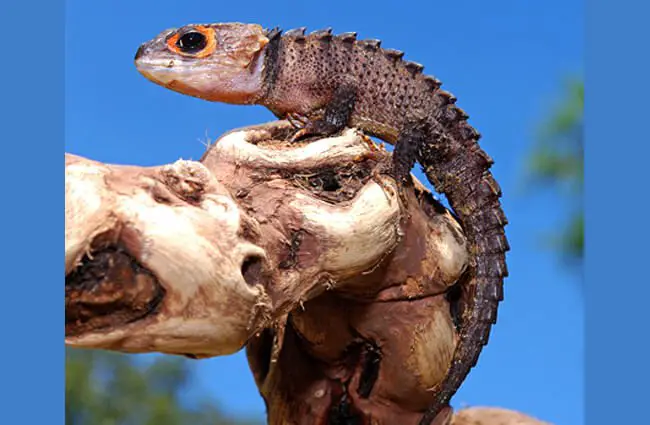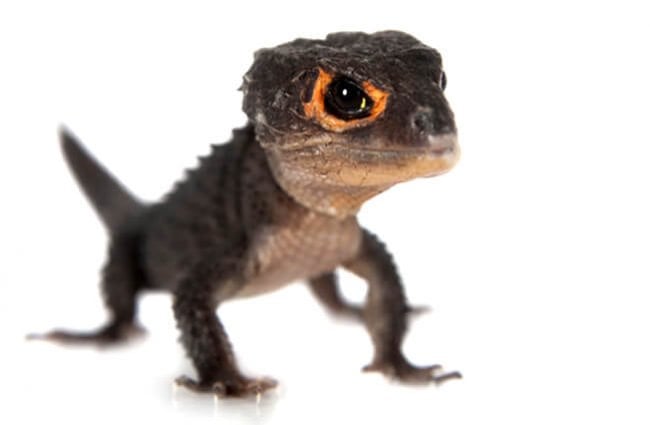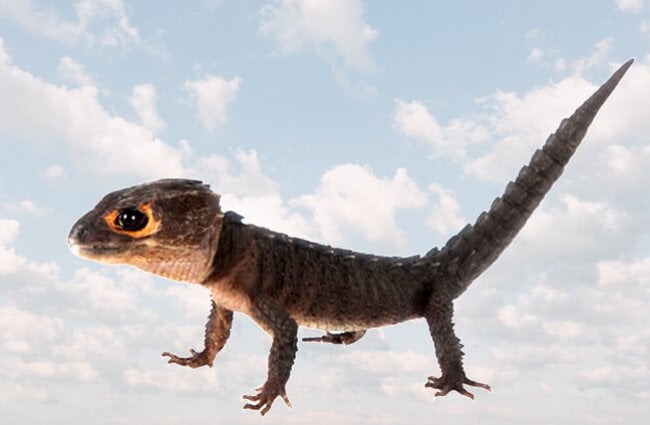The rainforests of New Guinea hold many secrets, and among them is a creature that seems to have stepped right out of a fantasy novel. Imagine a miniature dragon, complete with spiky armor and piercing eyes, yet small enough to fit in the palm of your hand. This is the Crocodile Skink, scientifically known as Tribolonotus gracilis, a reptile that captivates with its prehistoric appearance and intriguing behaviors. Far from being a mythical beast, this fascinating skink offers a wealth of knowledge for anyone curious about the natural world, from the casual observer to the dedicated researcher.
Often referred to as the “Red-Eyed Crocodile Skink” due to its distinctive orange or red eye rings, this species is a marvel of adaptation and a testament to the incredible diversity of life on Earth. Its unique characteristics make it a subject of great interest, whether you are studying its evolutionary path, observing its role in its native ecosystem, or simply admiring its beauty.

Unveiling the Crocodile Skink: Basic Biology
To truly appreciate the Crocodile Skink, one must first understand its fundamental biology. This creature, though small, possesses a suite of features that make it stand out in the reptilian world.
Appearance and Distinguishing Features
The most striking feature of the Crocodile Skink is its heavily armored body. Covered in rows of keeled, spiky scales, it bears a remarkable resemblance to a miniature crocodilian, hence its common name. These osteoderms, bony plates beneath the scales, provide excellent protection against predators. The skink’s coloration typically ranges from dark brown to black on its dorsal side, providing camouflage within its dimly lit rainforest habitat. Its ventral side is often lighter, a creamy white or yellowish hue. Adding to its allure are the prominent orange or red rings around its eyes, which give it a perpetually alert and somewhat fierce expression. Adults typically reach a modest size, averaging between 8 to 10 inches (20 to 25 cm) in total length, including the tail.
Where in the World? Habitat and Range
The Crocodile Skink is endemic to the island of New Guinea, primarily inhabiting the lowland rainforests. Its preferred habitat is characterized by high humidity, consistent temperatures, and an abundance of leaf litter and decaying wood. Crucially, these skinks are semi-aquatic, meaning they are never found far from water sources. They thrive in areas adjacent to streams, rivers, and ponds, where they can readily retreat into the water or hide among the dense vegetation and submerged debris. This close association with water is a key aspect of their survival strategy, offering both refuge and a hunting ground.

Life in the Wild: Ecology and Behavior
Understanding how Crocodile Skinks live in their natural environment provides invaluable insights into their adaptations and ecological role.
A Day in the Life: Diet and Foraging
Crocodile Skinks are primarily insectivorous, meaning their diet consists mainly of insects and other small invertebrates. They are opportunistic hunters, often foraging during crepuscular hours (dawn and dusk) or at night, though they can be active during the day in shaded, humid conditions. Their keen eyesight, aided by those distinctive eye rings, helps them spot prey in low light. Common food items include crickets, mealworms, roaches, small snails, and various other terrestrial invertebrates found within the leaf litter or near water bodies. Their strong jaws are well-suited for crushing the exoskeletons of their prey.
The Dance of Life: Mating and Reproduction
Reproduction in Crocodile Skinks is particularly interesting. Unlike many skink species that lay eggs, Tribolonotus gracilis is ovoviviparous, meaning the female retains the eggs internally until they hatch, giving birth to live young. This reproductive strategy is often seen in species inhabiting cooler or more variable environments, though New Guinea’s climate is relatively stable. Females typically lay a single, large egg at a time, which develops internally. After a gestation period, a fully formed, miniature skink emerges. This species also exhibits a degree of parental care, which is quite rare among skinks. The female may guard her offspring for a period, a behavior that enhances the survival chances of the young. Sexual dimorphism can be observed, with males often possessing more prominent femoral pores and sometimes a broader head, though these differences can be subtle.

Crocodile Skinks in the Ecosystem: Interactions and Importance
Every species plays a role in its ecosystem, and the Crocodile Skink is no exception, contributing to the delicate balance of its rainforest home.
Role in the Food Web
As insectivores, Crocodile Skinks serve as important predators of various invertebrates, helping to regulate insect populations within their habitat. This role is crucial for maintaining the health of the rainforest ecosystem. In turn, they can become prey for larger animals, such as snakes, birds of prey, and possibly larger mammals or monitor lizards. Their cryptic coloration, armored scales, and tendency to hide or flee into water are all adaptations to minimize their risk of predation.
Coexisting with Other Creatures
Crocodile Skinks are generally solitary and shy creatures. They spend much of their time hidden beneath leaf litter, logs, or in burrows, emerging primarily to hunt. Their interactions with other animals are largely limited to predator-prey relationships or competition for resources. They are not known to form complex social structures with other species, preferring to maintain a low profile within their dense habitat.

Human Connection: Culture, Conservation, and Coexistence
While not a prominent figure in human folklore, Crocodile Skinks do interact with humans in several significant ways.
Crocodile Skinks and Human Culture
Unlike some larger, more charismatic reptiles, Crocodile Skinks have a limited direct presence in the traditional cultures or folklore of New Guinea’s indigenous peoples. However, their unique appearance has made them highly sought after in the exotic pet trade. This demand, while highlighting their aesthetic appeal, also presents challenges for their wild populations. For reptile enthusiasts and hobbyists, they represent a captivating species, often admired for their docile nature and striking looks.
Encountering a Crocodile Skink in the Wild
For the animal lover or hiker hoping to spot a Crocodile Skink in its native habitat, patience and a keen eye are essential. These skinks are masters of camouflage and highly reclusive. The best places to search are humid, forested areas near slow-moving streams or ponds in New Guinea. Look under leaf litter, decaying logs, and rocks, especially at dawn or dusk. If you are fortunate enough to encounter one, the best course of action is simply to observe from a respectful distance. Avoid attempting to handle or disturb the animal. Its spiky scales, while protective, can be uncomfortable if handled improperly, and stressing the animal can lead to negative health outcomes for it. Simply appreciate the rare sight of this living dragon in its natural home.
Conservation Status and Human Impact
The conservation status of the Crocodile Skink is currently listed as “Least Concern” by the IUCN, primarily due to its relatively wide distribution across New Guinea. However, local populations can be threatened by habitat degradation and loss due to deforestation, agriculture, and human settlement. The pet trade also poses a potential threat, as unsustainable collection practices could deplete wild numbers. Responsible pet ownership, including sourcing from captive-bred individuals, is crucial to mitigate this impact. Understanding and protecting their unique rainforest habitat is key to ensuring the long-term survival of this remarkable species.

Deeper Dive: For the Aspiring Zoologist and Enthusiast
Beyond the basics, the Crocodile Skink offers a wealth of fascinating details for those seeking a more profound understanding.
Evolutionary Journey of the Crocodile Skink
The Crocodile Skink belongs to the family Scincidae, one of the most diverse families of lizards. Its genus, Tribolonotus, is unique within this family due to its heavily armored body and ovoviviparous reproduction. The development of its prominent osteoderms and spiky scales is a remarkable example of convergent evolution, where unrelated species develop similar traits due to similar environmental pressures. In this case, the need for protection against predators in a dense, humid environment likely drove the evolution of its crocodilian-like armor. Its semi-aquatic lifestyle also represents a specialized adaptation within a largely terrestrial group of lizards, highlighting the evolutionary flexibility of skinks to exploit various ecological niches.
Fascinating Facts and Unique Adaptations
- Vocalization: Crocodile Skinks are one of the few lizard species known to vocalize. When stressed or threatened, they can emit a high-pitched squeak or bark, a surprising sound from such a small reptile.
- Playing Dead: Like some other reptiles, Crocodile Skinks may engage in thanatosis, or “playing dead,” when severely threatened. They will lie motionless, sometimes on their back, to deter predators.
- Tail Autotomy: While not as prone to it as some other skinks, Crocodile Skinks can still shed their tails (autotomy) as a defense mechanism when grasped by a predator. The detached tail wiggles, distracting the predator while the skink escapes. The tail will eventually regenerate, though often not to its original perfection.
- Nocturnal/Crepuscular Activity: While often active during the day in captivity, in the wild, their activity peaks during twilight hours and at night, allowing them to avoid diurnal predators and take advantage of higher humidity.
- Distinctive Eye Rings: The bright orange or red eye rings are not just for show; they may play a role in species recognition or even in deterring predators by making the skink appear more formidable.
Caring for Crocodile Skinks: A Zookeeper’s Guide
For zookeepers and dedicated hobbyists, providing optimal care for Crocodile Skinks in captivity requires attention to detail and an understanding of their specific needs.
Creating the Ideal Habitat in Captivity
A naturalistic terrarium is paramount for the well-being of Crocodile Skinks. The enclosure should be spacious, allowing for exploration and the creation of a proper thermal gradient. Key elements include:
- Substrate: A deep layer of moisture-retaining substrate is essential. Options include coco fiber, sphagnum moss, cypress mulch, or a bioactive mix. This allows for burrowing and helps maintain high humidity.
- Humidity: High humidity, typically between 70-90%, is critical. This can be achieved through regular misting, a large water feature, and appropriate substrate.
- Temperature: A temperature gradient should be provided, with ambient temperatures ranging from 72-78°F (22-26°C) and a basking spot reaching 80-85°F (27-29°C). Nighttime temperatures can drop slightly but should not fall below 70°F (21°C).
- Water Feature: A large, shallow water dish or a small pond area is crucial, as they are semi-aquatic. The water should be kept meticulously clean.
- Hiding Spots: Abundant hiding spots are necessary to reduce stress. These can include cork bark, hollow logs, rock caves, and dense live or artificial plants.
- Lighting: While primarily crepuscular/nocturnal, a low-level UVB light source is beneficial for overall health and vitamin D3 synthesis.
Dietary Needs and Feeding Regimen
In captivity, a varied diet of appropriately sized insects is vital. This includes:
- Crickets
- Mealworms and superworms (in moderation)
- Dubia roaches
- Small snails
- Silkworms
All feeder insects should be gut-loaded with nutritious foods before being offered. Additionally, dusting insects with a calcium supplement (without D3) at every feeding and a multivitamin supplement (with D3) once or twice a week is crucial to prevent nutritional deficiencies like Metabolic Bone Disease.
Health Monitoring and Common Ailments
Regular observation is key to identifying potential health issues. Zookeepers should look for:
- Shedding Issues: Incomplete sheds, especially around the eyes or toes, can indicate insufficient humidity.
- Lethargy or Anorexia: These can be signs of illness, stress, or improper environmental conditions.
- Parasites: Internal parasites can be detected through fecal exams, while external parasites like mites may be visible on the skink.
- Respiratory Infections: Open-mouth breathing, wheezing, or nasal discharge can indicate a respiratory issue, often linked to low humidity or improper temperatures.
- Metabolic Bone Disease (MBD): Soft jaws, tremors, or deformities can result from calcium or D3 deficiency.
Breeding in Captivity
Breeding Crocodile Skinks in captivity can be challenging but rewarding. Providing optimal conditions, including a slight cooling period to simulate seasonal changes, can encourage breeding. Given their ovoviviparous nature, monitoring the female for signs of pregnancy and providing a secure, humid birthing area is important. The single, relatively large offspring will be miniature versions of the adults and require similar care, though with smaller food items.
What to Do and What to Avoid
- Do:
- Provide a spacious, naturalistic enclosure with ample hiding spots and a water feature.
- Maintain high humidity and appropriate temperature gradients.
- Offer a varied, gut-loaded, and supplemented insect diet.
- Observe behavior daily for signs of stress or illness.
- Provide enrichment through varied substrate, climbing opportunities, and occasional changes to the enclosure layout.
- Handle gently and infrequently, only when necessary for health checks or enclosure maintenance.
- Avoid:
- Overhandling or frequent handling, as this can cause significant stress.
- Cohabiting with other species or even multiple Crocodile Skinks unless a proven breeding pair in a very large enclosure, as they can be territorial.
- Allowing humidity to drop too low, which can lead to shedding problems and respiratory issues.
- Feeding an unvaried diet or neglecting supplementation.
- Using harsh chemical cleaners in the enclosure; opt for reptile-safe disinfectants.
- Placing the enclosure in high-traffic areas or where it will experience sudden temperature fluctuations.
Conclusion: A Small Dragon’s Enduring Charm
The Crocodile Skink, with its ancient appearance and secretive nature, is a testament to the wonders of evolution. From its spiky armor and red-ringed eyes to its unique reproductive strategy and semi-aquatic lifestyle, every aspect of Tribolonotus gracilis tells a story of adaptation and survival in the lush rainforests of New Guinea. Whether you are a student delving into its ecological role, an animal lover hoping for a glimpse in the wild, an aspiring zoologist studying its evolutionary path, or a dedicated zookeeper providing meticulous care, the Crocodile Skink offers endless opportunities for learning and appreciation. Protecting its habitat and understanding its needs are crucial steps in ensuring that this magnificent mini-dragon continues to thrive for generations to come, a living jewel of the natural world.

![Red Angus Closeup of a beautiful Red Angus cowPhoto by: U.S. Department of Agriculture [pubic domain]https://creativecommons.org/licenses/by/2.0/](https://animals.net/wp-content/uploads/2020/03/Red-Angus-4-238x178.jpg)




![Red Angus Closeup of a beautiful Red Angus cowPhoto by: U.S. Department of Agriculture [pubic domain]https://creativecommons.org/licenses/by/2.0/](https://animals.net/wp-content/uploads/2020/03/Red-Angus-4-100x75.jpg)

